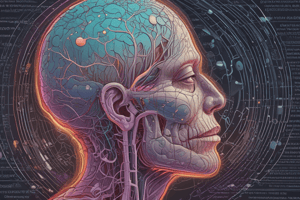Podcast
Questions and Answers
What is the primary concern when a patient with ischemic stroke is admitted to the emergency department?
What is the primary concern when a patient with ischemic stroke is admitted to the emergency department?
- Conducting an MRI perfusion and diffusion study to assess the penumbra
- Stabilizing the patient's vital signs and treating hypoglycemia (correct)
- Performing a CT brain scan to rule out hemorrhage
- Administering thrombolytic therapy within the 3.5-hour window
What is the significance of a 'hypodense area' on a CT brain scan in the context of ischemic stroke?
What is the significance of a 'hypodense area' on a CT brain scan in the context of ischemic stroke?
- It indicates a hemorrhagic stroke
- It suggests a diagnosis of hypoglycemia
- It confirms the presence of an ischemic stroke (correct)
- It is a normal variant in the CT brain scan
What is the primary goal of thrombolytic therapy in the treatment of acute ischemic stroke?
What is the primary goal of thrombolytic therapy in the treatment of acute ischemic stroke?
- To treat hypoglycemia
- To manage the patient's vital signs
- To restore blood flow to the affected area of the brain (correct)
- To reduce the risk of hemorrhage
What is the significance of the 3.5-hour window in the context of thrombolytic therapy for acute ischemic stroke?
What is the significance of the 3.5-hour window in the context of thrombolytic therapy for acute ischemic stroke?
What is the name of the medication used in thrombolytic therapy for acute ischemic stroke?
What is the name of the medication used in thrombolytic therapy for acute ischemic stroke?
What is the primary advantage of Tenecteplase over other thrombolytic agents?
What is the primary advantage of Tenecteplase over other thrombolytic agents?
What is the primary indication for performing an MRI perfusion and diffusion study in patients with acute ischemic stroke?
What is the primary indication for performing an MRI perfusion and diffusion study in patients with acute ischemic stroke?
What is the primary outcome of a CT brain scan that is 'free' in the context of acute ischemic stroke?
What is the primary outcome of a CT brain scan that is 'free' in the context of acute ischemic stroke?
What is the significance of the 'brain is time' concept in the context of acute ischemic stroke?
What is the significance of the 'brain is time' concept in the context of acute ischemic stroke?
What is the primary goal of the 'TTT' approach in the management of acute ischemic stroke?
What is the primary goal of the 'TTT' approach in the management of acute ischemic stroke?
Flashcards are hidden until you start studying
Study Notes
Stroke Rehabilitation
- Physiotherapist plays a crucial role in rehabilitation after the first few days of stroke
- Medical TTT (Thrombolytic Therapy) and lifestyle changes are essential for prevention
- Prevention of stroke requires control of thrombus formation and medical TTT
Types of Stroke
- Ischemic stroke: characterized by a hypodense area in CT brain scans
- Hemorrhagic stroke: characterized by white color in CT scans
CT Brain Scans
- CT brain scan is essential to determine the type of stroke
- Ischemic stroke appears as a hypodense area in CT scans
- Hemorrhagic stroke appears as a white color in CT scans
TTT of Acute Ischemic Stroke
- TTT consists of maintenance of vital signs, specific TTT, and nursing care
- Thrombolytic therapy is administered within 3.5 hours of stroke onset
- Two types of thrombolytic therapy: Tissue plasminogen activating factor (TPA) and Tenecteplase
- TPA is commonly used in Egypt
- Tenecteplase is administered directly IV and is more cost-effective
- Advanced imaging techniques (MRI perfusion and diffusion) are used to identify penumbra area
- Thrombolytic therapy is administered if the patient is within the 3-4.5 hour window
Initial Assessment
- Initial assessment includes venous access, Ryle's tube insertion, and urinary catheterization
- Check for airway, breathing, and circulation (ABCs) before CT scan
- CT brain scan is essential to determine the type of stroke
Studying That Suits You
Use AI to generate personalized quizzes and flashcards to suit your learning preferences.





